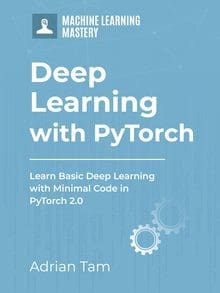Training a neural network or large deep learning model is a difficult optimization task.
The classical algorithm to train neural networks is called stochastic gradient descent. It has been well established that you can achieve increased performance and faster training on some problems by using a learning rate that changes during training.
In this post, you will discover what is learning rate schedule and how you can use different learning rate schedules for your neural network models in PyTorch.
After reading this post, you will know:
- The role of learning rate schedule in model training
- How to use learning rate schedule in PyTorch training loop
- How to set up your own learning rate schedule
Want to Get Started With Deep Learning with PyTorch?
Take my free email crash course now (with sample code).
Click to sign-up and also get a free PDF Ebook version of the course.
Let’s get started.

Using Learning Rate Schedule in PyTorch Training
Photo by Cheung Yin. Some rights reserved.
Overview
This post is divided into three parts; they are
- Learning Rate Schedule for Training Models
- Applying Learning Rate Schedule in PyTorch Training
- Custom Learning Rate Schedules
Learning Rate Schedule for Training Models
Gradient descent is an algorithm of numerical optimization. What it does is to update parameters using the formula:
$$
w := w – \alpha \dfrac{dy}{dw}
$$
In this formula, $w$ is the parameter, e.g., the weight in a neural network, and $y$ is the objective, e.g., the loss function. What it does is to move $w$ to the direction that you can minimize $y$. The direction is provided by the differentiation, $\dfrac{dy}{dw}$, but how much you should move $w$ is controlled by the learning rate $\alpha$.
An easy start is to use a constant learning rate in gradient descent algorithm. But you can do better with a learning rate schedule. A schedule is to make learning rate adaptive to the gradient descent optimization procedure, so you can increase performance and reduce training time.
In the neural network training process, data is feed into the network in batches, with many batches in one epoch. Each batch triggers one training step, which the gradient descent algorithm updates the parameters once. However, usually the learning rate schedule is updated once for each training epoch only.
You can update the learning rate as frequent as each step but usually it is updated once per epoch because you want to know how the network performs in order to determine how the learning rate should update. Regularly, a model is evaluated with validation dataset once per epoch.
There are multiple ways of making learning rate adaptive. At the beginning of training, you may prefer a larger learning rate so you improve the network coarsely to speed up the progress. In a very complex neural network model, you may also prefer to gradually increasse the learning rate at the beginning because you need the network to explore on the different dimensions of prediction. At the end of training, however, you always want to have the learning rate smaller. Since at that time, you are about to get the best performance from the model and it is easy to overshoot if the learning rate is large.
Therefore, the simplest and perhaps most used adaptation of the learning rate during training are techniques that reduce the learning rate over time. These have the benefit of making large changes at the beginning of the training procedure when larger learning rate values are used and decreasing the learning rate so that a smaller rate and, therefore, smaller training updates are made to weights later in the training procedure.
This has the effect of quickly learning good weights early and fine-tuning them later.
Next, let’s look at how you can set up learning rate schedules in PyTorch.
Kick-start your project with my book Deep Learning with PyTorch. It provides self-study tutorials with working code.
Applying Learning Rate Schedules in PyTorch Training
In PyTorch, a model is updated by an optimizer and learning rate is a parameter of the optimizer. Learning rate schedule is an algorithm to update the learning rate in an optimizer.
Below is an example of creating a learning rate schedule:
|
1 2 3 4 5 |
import torch import torch.optim as optim import torch.optim.lr_scheduler as lr_scheduler scheduler = lr_scheduler.LinearLR(optimizer, start_factor=1.0, end_factor=0.3, total_iters=10) |
There are many learning rate scheduler provided by PyTorch in torch.optim.lr_scheduler submodule. All the scheduler needs the optimizer to update as first argument. Depends on the scheduler, you may need to provide more arguments to set up one.
Let’s start with an example model. In below, a model is to solve the ionosphere binary classification problem. This is a small dataset that you can download from the UCI Machine Learning repository. Place the data file in your working directory with the filename ionosphere.csv.
The ionosphere dataset is good for practicing with neural networks because all the input values are small numerical values of the same scale.
A small neural network model is constructed with a single hidden layer with 34 neurons, using the ReLU activation function. The output layer has a single neuron and uses the sigmoid activation function in order to output probability-like values.
Plain stochastic gradient descent algorithm is used, with a fixed learning rate 0.1. The model is trained for 50 epochs. The state parameters of an optimizer can be found in optimizer.param_groups; which the learning rate is a floating point value at optimizer.param_groups[0]["lr"]. At the end of each epoch, the learning rate from the optimizer is printed.
The complete example is listed below.
|
1 2 3 4 5 6 7 8 9 10 11 12 13 14 15 16 17 18 19 20 21 22 23 24 25 26 27 28 29 30 31 32 33 34 35 36 37 38 39 40 41 42 43 44 45 46 47 48 49 50 51 52 53 54 55 56 57 58 59 |
import numpy as np import pandas as pd import torch import torch.nn as nn import torch.optim as optim from sklearn.preprocessing import LabelEncoder from sklearn.model_selection import train_test_split # load dataset, split into input (X) and output (y) variables dataframe = pd.read_csv("ionosphere.csv", header=None) dataset = dataframe.values X = dataset[:,0:34].astype(float) y = dataset[:,34] # encode class values as integers encoder = LabelEncoder() encoder.fit(y) y = encoder.transform(y) # convert into PyTorch tensors X = torch.tensor(X, dtype=torch.float32) y = torch.tensor(y, dtype=torch.float32).reshape(-1, 1) # train-test split for evaluation of the model X_train, X_test, y_train, y_test = train_test_split(X, y, train_size=0.7, shuffle=True) # create model model = nn.Sequential( nn.Linear(34, 34), nn.ReLU(), nn.Linear(34, 1), nn.Sigmoid() ) # Train the model n_epochs = 50 batch_size = 24 batch_start = torch.arange(0, len(X_train), batch_size) lr = 0.1 loss_fn = nn.BCELoss() optimizer = optim.SGD(model.parameters(), lr=lr) model.train() for epoch in range(n_epochs): for start in batch_start: X_batch = X_train[start:start+batch_size] y_batch = y_train[start:start+batch_size] y_pred = model(X_batch) loss = loss_fn(y_pred, y_batch) optimizer.zero_grad() loss.backward() optimizer.step() print("Epoch %d: SGD lr=%.4f" % (epoch, optimizer.param_groups[0]["lr"])) # evaluate accuracy after training model.eval() y_pred = model(X_test) acc = (y_pred.round() == y_test).float().mean() acc = float(acc) print("Model accuracy: %.2f%%" % (acc*100)) |
Running this model produces:
|
1 2 3 4 5 6 7 8 9 10 11 12 |
Epoch 0: SGD lr=0.1000 Epoch 1: SGD lr=0.1000 Epoch 2: SGD lr=0.1000 Epoch 3: SGD lr=0.1000 Epoch 4: SGD lr=0.1000 ... Epoch 45: SGD lr=0.1000 Epoch 46: SGD lr=0.1000 Epoch 47: SGD lr=0.1000 Epoch 48: SGD lr=0.1000 Epoch 49: SGD lr=0.1000 Model accuracy: 86.79% |
You can confirm that the learning rate didn’t change over the entire training process. Let’s make the training process start with a larger learning rate and end with a smaller rate. To introduce a learning rate scheduler, you need to run its step() function in the training loop. The code above is modified into the following:
|
1 2 3 4 5 6 7 8 9 10 11 12 13 14 15 16 17 18 19 20 21 22 23 24 25 26 27 28 29 30 31 32 33 34 35 36 37 38 39 40 41 42 43 44 45 46 47 48 49 50 51 52 53 54 55 56 57 58 59 60 61 62 63 64 |
import numpy as np import pandas as pd import torch import torch.nn as nn import torch.optim as optim import torch.optim.lr_scheduler as lr_scheduler from sklearn.preprocessing import LabelEncoder from sklearn.model_selection import train_test_split # load dataset, split into input (X) and output (y) variables dataframe = pd.read_csv("ionosphere.csv", header=None) dataset = dataframe.values X = dataset[:,0:34].astype(float) y = dataset[:,34] # encode class values as integers encoder = LabelEncoder() encoder.fit(y) y = encoder.transform(y) # convert into PyTorch tensors X = torch.tensor(X, dtype=torch.float32) y = torch.tensor(y, dtype=torch.float32).reshape(-1, 1) # train-test split for evaluation of the model X_train, X_test, y_train, y_test = train_test_split(X, y, train_size=0.7, shuffle=True) # create model model = nn.Sequential( nn.Linear(34, 34), nn.ReLU(), nn.Linear(34, 1), nn.Sigmoid() ) # Train the model n_epochs = 50 batch_size = 24 batch_start = torch.arange(0, len(X_train), batch_size) lr = 0.1 loss_fn = nn.BCELoss() optimizer = optim.SGD(model.parameters(), lr=lr) scheduler = lr_scheduler.LinearLR(optimizer, start_factor=1.0, end_factor=0.5, total_iters=30) model.train() for epoch in range(n_epochs): for start in batch_start: X_batch = X_train[start:start+batch_size] y_batch = y_train[start:start+batch_size] y_pred = model(X_batch) loss = loss_fn(y_pred, y_batch) optimizer.zero_grad() loss.backward() optimizer.step() before_lr = optimizer.param_groups[0]["lr"] scheduler.step() after_lr = optimizer.param_groups[0]["lr"] print("Epoch %d: SGD lr %.4f -> %.4f" % (epoch, before_lr, after_lr)) # evaluate accuracy after training model.eval() y_pred = model(X_test) acc = (y_pred.round() == y_test).float().mean() acc = float(acc) print("Model accuracy: %.2f%%" % (acc*100)) |
It prints:
|
1 2 3 4 5 6 7 8 9 10 11 12 13 14 |
Epoch 0: SGD lr 0.1000 -> 0.0983 Epoch 1: SGD lr 0.0983 -> 0.0967 Epoch 2: SGD lr 0.0967 -> 0.0950 Epoch 3: SGD lr 0.0950 -> 0.0933 Epoch 4: SGD lr 0.0933 -> 0.0917 ... Epoch 28: SGD lr 0.0533 -> 0.0517 Epoch 29: SGD lr 0.0517 -> 0.0500 Epoch 30: SGD lr 0.0500 -> 0.0500 Epoch 31: SGD lr 0.0500 -> 0.0500 ... Epoch 48: SGD lr 0.0500 -> 0.0500 Epoch 49: SGD lr 0.0500 -> 0.0500 Model accuracy: 88.68% |
In the above, LinearLR() is used. It is a linear rate scheduler and it takes three additional parameters, the start_factor, end_factor, and total_iters. You set start_factor to 1.0, end_factor to 0.5, and total_iters to 30, therefore it will make a multiplicative factor decrease from 1.0 to 0.5, in 10 equal steps. After 10 steps, the factor will stay at 0.5. This factor is then multiplied to the original learning rate at the optimizer. Hence you will see the learning rate decreased from $0.1\times 1.0 = 0.1$ to $0.1\times 0.5 = 0.05$.
Besides LinearLR(), you can also use ExponentialLR(), its syntax is:
|
1 |
scheduler = lr_scheduler.ExponentialLR(optimizer, gamma=0.99) |
If you replaced LinearLR() with this, you will see the learning rate updated as follows:
|
1 2 3 4 5 6 7 8 9 10 11 |
Epoch 0: SGD lr 0.1000 -> 0.0990 Epoch 1: SGD lr 0.0990 -> 0.0980 Epoch 2: SGD lr 0.0980 -> 0.0970 Epoch 3: SGD lr 0.0970 -> 0.0961 Epoch 4: SGD lr 0.0961 -> 0.0951 ... Epoch 45: SGD lr 0.0636 -> 0.0630 Epoch 46: SGD lr 0.0630 -> 0.0624 Epoch 47: SGD lr 0.0624 -> 0.0617 Epoch 48: SGD lr 0.0617 -> 0.0611 Epoch 49: SGD lr 0.0611 -> 0.0605 |
In which the learning rate is updated by multiplying with a constant factor gamma in each scheduler update.
Custom Learning Rate Schedules
There is no general rule that a particular learning rate schedule works the best. Sometimes, you like to have a special learning rate schedule that PyTorch didn’t provide. A custom learning rate schedule can be defined using a custom function. For example, you want to have a learning rate that:
$$
lr_n = \dfrac{lr_0}{1 + \alpha n}
$$
on epoch $n$, which $lr_0$ is the initial learning rate, at epoch 0, and $\alpha$ is a constant. You can implement a function that given the epoch $n$ calculate learning rate $lr_n$:
|
1 2 3 4 5 |
def lr_lambda(epoch): # LR to be 0.1 * (1/1+0.01*epoch) base_lr = 0.1 factor = 0.01 return base_lr/(1+factor*epoch) |
Then, you can set up a LambdaLR() to update the learning rate according to this function:
|
1 |
scheduler = lr_scheduler.LambdaLR(optimizer, lr_lambda) |
Modifying the previous example to use LambdaLR(), you have the following:
|
1 2 3 4 5 6 7 8 9 10 11 12 13 14 15 16 17 18 19 20 21 22 23 24 25 26 27 28 29 30 31 32 33 34 35 36 37 38 39 40 41 42 43 44 45 46 47 48 49 50 51 52 53 54 55 56 57 58 59 60 61 62 63 64 65 66 67 68 69 70 |
import numpy as np import pandas as pd import torch import torch.nn as nn import torch.optim as optim import torch.optim.lr_scheduler as lr_scheduler from sklearn.preprocessing import LabelEncoder from sklearn.model_selection import train_test_split # load dataset, split into input (X) and output (y) variables dataframe = pd.read_csv("ionosphere.csv", header=None) dataset = dataframe.values X = dataset[:,0:34].astype(float) y = dataset[:,34] # encode class values as integers encoder = LabelEncoder() encoder.fit(y) y = encoder.transform(y) # convert into PyTorch tensors X = torch.tensor(X, dtype=torch.float32) y = torch.tensor(y, dtype=torch.float32).reshape(-1, 1) # train-test split for evaluation of the model X_train, X_test, y_train, y_test = train_test_split(X, y, train_size=0.7, shuffle=True) # create model model = nn.Sequential( nn.Linear(34, 34), nn.ReLU(), nn.Linear(34, 1), nn.Sigmoid() ) def lr_lambda(epoch): # LR to be 0.1 * (1/1+0.01*epoch) base_lr = 0.1 factor = 0.01 return base_lr/(1+factor*epoch) # Train the model n_epochs = 50 batch_size = 24 batch_start = torch.arange(0, len(X_train), batch_size) lr = 0.1 loss_fn = nn.BCELoss() optimizer = optim.SGD(model.parameters(), lr=lr) scheduler = lr_scheduler.LambdaLR(optimizer, lr_lambda) model.train() for epoch in range(n_epochs): for start in batch_start: X_batch = X_train[start:start+batch_size] y_batch = y_train[start:start+batch_size] y_pred = model(X_batch) loss = loss_fn(y_pred, y_batch) optimizer.zero_grad() loss.backward() optimizer.step() before_lr = optimizer.param_groups[0]["lr"] scheduler.step() after_lr = optimizer.param_groups[0]["lr"] print("Epoch %d: SGD lr %.4f -> %.4f" % (epoch, before_lr, after_lr)) # evaluate accuracy after training model.eval() y_pred = model(X_test) acc = (y_pred.round() == y_test).float().mean() acc = float(acc) print("Model accuracy: %.2f%%" % (acc*100)) |
Which produces:
|
1 2 3 4 5 6 7 8 9 10 11 |
Epoch 0: SGD lr 0.0100 -> 0.0099 Epoch 1: SGD lr 0.0099 -> 0.0098 Epoch 2: SGD lr 0.0098 -> 0.0097 Epoch 3: SGD lr 0.0097 -> 0.0096 Epoch 4: SGD lr 0.0096 -> 0.0095 ... Epoch 45: SGD lr 0.0069 -> 0.0068 Epoch 46: SGD lr 0.0068 -> 0.0068 Epoch 47: SGD lr 0.0068 -> 0.0068 Epoch 48: SGD lr 0.0068 -> 0.0067 Epoch 49: SGD lr 0.0067 -> 0.0067 |
Note that although the function provided to LambdaLR() assumes an argument epoch, it is not tied to the epoch in the training loop but simply counts how many times you invoked scheduler.step().
Tips for Using Learning Rate Schedules
This section lists some tips and tricks to consider when using learning rate schedules with neural networks.
- Increase the initial learning rate. Because the learning rate will very likely decrease, start with a larger value to decrease from. A larger learning rate will result in a lot larger changes to the weights, at least in the beginning, allowing you to benefit from the fine-tuning later.
- Use a large momentum. Many optimizers can consider momentum. Using a larger momentum value will help the optimization algorithm continue to make updates in the right direction when your learning rate shrinks to small values.
- Experiment with different schedules. It will not be clear which learning rate schedule to use, so try a few with different configuration options and see what works best on your problem. Also, try schedules that change exponentially and even schedules that respond to the accuracy of your model on the training or test datasets.
Further Readings
Below is the documentation for more details on using learning rates in PyTorch:
- How to adjust learning rate, from PyTorch documentation
Summary
In this post, you discovered learning rate schedules for training neural network models.
After reading this post, you learned:
- How learning rate affects your model training
- How to set up learning rate schedule in PyTorch
- How to create a custom learning rate schedule








A fine article, but full of grammatical errors that sometimes make it hard to follow.
Thank you Tanner for your feedback!
lr_lambda doesn’t need to multiply base_lr at the end. If you look at the PyTorch’s source code, LambdaLR.get_lr does that for you.
Thank you for the clarification FelixHao!
Can this learning rate scheduler be also used with Adam?
Hi SuBele…This would be unecessary when using Adam.
https://ai.stackexchange.com/questions/35041/do-learning-rate-schedulers-conflict-with-or-prevent-convergence-of-the-adam-opt#:~:text=Because%20Adam%20manages%20learning%20rates,causing%20model%20convergence%20to%20worsen.